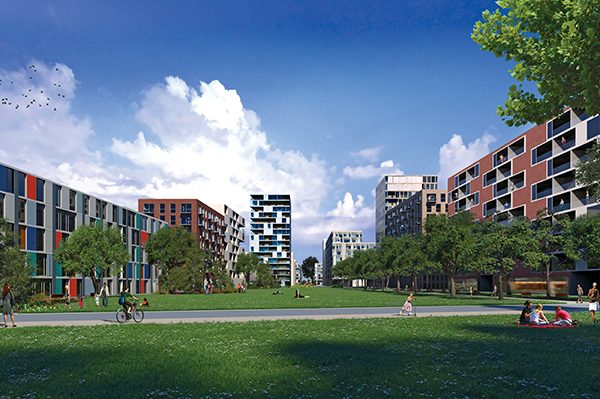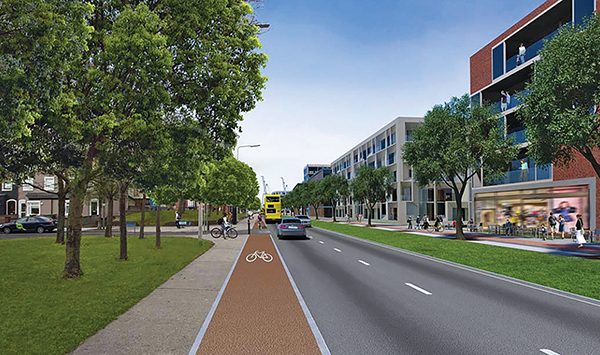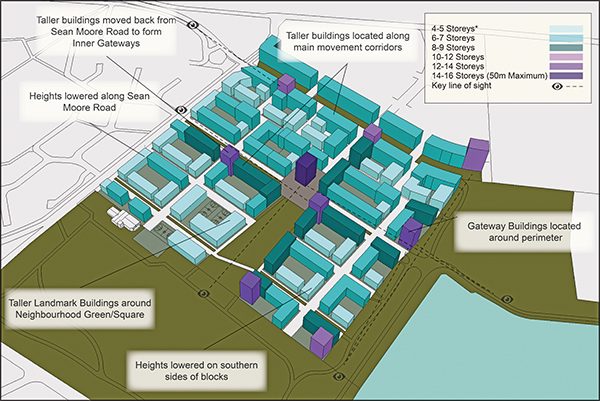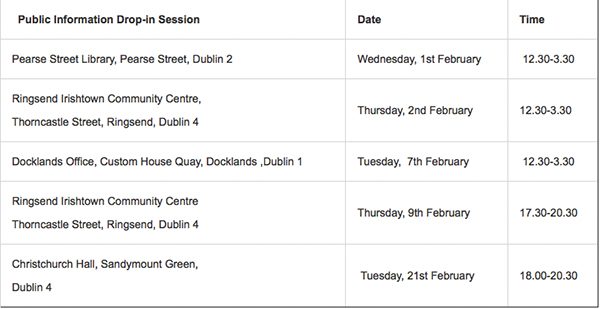
Above: Artist’s impression of ‘village green’ within new development.
Image courtesy of Dublin City Council.
Dublin City Council (DCC) has recently released its draft plan for the development of the Poolbeg West, Strategic Development Zone (SDZ), the 34-hectare area which includes the Irish Glass Bottle (IGB) factory site.
The Draft Poolbeg West SDZ Planning Scheme 2017, published on January 24th, is seen as a serious indication of how DCC currently intend to handle the development of the area.
Implementation of the plan envisages 3,000 homes built in blocks of up to 50 metres in height, with some 100,000 square metres of commercial and retail space that, it is claimed, would accommodate 8,000 jobs.
A primary school, childcare facilities and outdoor playgrounds are provided under the plan, and it would “seek to ensure that developments in Poolbeg West contribute to the 5% allocation of space in the docklands area to be used for social, cultural, creative and artistic purposes.”
The Luas Red Line would be extended into the area, along with enhanced bus services, a new bridge over the Dodder, cycling routes and pedestrian access.
The plan states that “the lands to the south of South Bank Road (which include the Irish Glass Bottle factory site) shall be developed at an approximate ratio of 80% residential and 20% commercial, complemented by community, recreational, retail and service uses at an appropriate scale to support a sustainable residential and working community with minimal commuting,” and goes on to announce that the development would accommodate a population of around 7,000 people.

Above: Artist’s impression of the new look of Sean Moore Road, with existing housing on the left. Images courtesy of Dublin City Council.
This means that, under the plan, the social housing provision could be as low as 10% of the overall housing development, a number that has been flatly rejected by local residents campaigning for a substantial social and affordable housing provision on the IGB site so as to accommodate the housing needs of the existing local community.
Speaking to NewsFour, architect, UCD lecturer and spokesperson for the IGB Housing Action Group, Mark Price, said: “We are aware that the council planners are bound by law on the 10% social and affordable housing provision. However, we have been working closely with all political parties and we are hopeful and confident that officials will find a way to significantly increase the social and affordable housing provision.”
Speaking of the IGB Housing Action Group’s own plan for the site (see page 4 of this issue for details) Price continued: “We believe that our plan makes social, environmental and financial sense, and that the site will not therefore become another developer-led apartment scheme. We have made submissions and we will continue to work on the finalisation of the plans with DCC councillors, who have been hugely supportive.”

Above: 3D perspective of the proposed scheme with sight lines and varying block heights.
With a housing and homelessness crisis in the city and wider state, and rents in the private rental sector soaring with little intervention from government, the issue of the provision of social and affordable housing in the Poolbeg SDZ development could not be of more importance to the survival of Dublin 4’s distinctive and historic docklands communities.
A series of Public Information Drop-in Sessions will be held during the DCC plan consultation period.
Members of the public and interested groups are invited to attend any session. They will occur as follows:

Above: Details of Public information drop-in sessions.
By Harry Bradley



